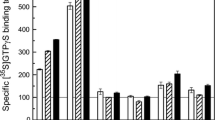Abstract
The effect of guanine nucleotide-binding protein (G protein) modifiers on the binding of the adenosine A2A receptor agonist 2-[4-(2-p-carboxyethyl[3H])phenyl-amino]-5’-N-ethylcarboxamidoadenosine ([3H]CGS 21680) and of the adenosine A1 receptor agonist [3H]R-phenylisopropyladenosine ([3H]R-PIA) to rat cortical and striatal membranes was studied. Guanosine 5’-(β,γ-imido)triphosphate (1–300 μM), which uncouples all G proteins, more effectively inhibited [3H]CGS 21680 (30 nM) binding in the cortex than [3H]R-PIA (2 nM) binding to cortical or striatal membranes or [3H]CGS 21680 (30 nM) binding in the striatum. N-Ethylmaleimide (1–300 μM) or pertussis toxin (1–100 μg/ml), which uncouple Gi/Go protein-coupled receptors, more effectively inhibited [3H]R-PIA binding to cortical or striatal membranes and [3H]CGS 21680 binding in the cortex than [3H]CGS 21680 binding in the striatum. Cholera toxin (2.5–250 μg/ml), which uncouples Gs protein-coupled receptors, more effectively inhibited [3H]CGS 21680 binding in the striatum than [3H]CGS 21680 binding in the cortex and less effectively inhibited [3H]R-PIA binding to cortical or striatal membranes. Treatment of solubilised cortical membranes with pertussis toxin (50 μg/ml) decreased [3H]CGS 21680 (30–100 nM) binding which almost fully recovered after reconstitution with Gi/Go proteins. The K i for displacement of [2-3H]-(4-{2-[7-amino-2-(2-furyl)(1,2,4)triazolo(2,3-a)(1,3,5)triazin-5-ylamino]ethyl}phenol) ([3H]ZM 241385, 1 nM) by CGS 21680 was 110 nM (95%CI: 98–122 nM) in non-treated, 230 (167–292) nM in pertussis toxin (25 μg/ml)-treated and 222 (150–295) nM in cholera toxin (50 μg/ml)-treated cortical membranes; in contrast, the K i for displacement of [3H]-5-amino-7-(2-phenylethyl)-2-(2-furyl)-pyrazolo(4,3-e)-1,2,4-triazolo(1,5-c)pyrimidine ([3H]SCH 58261, 1 nM) by CGS 21680 was 74 (57–91) nM in non-treated, 71 (44–100) nM in pertussis toxin-treated and 147 (100–193) nM in cholera toxin-treated cortical membranes. Finally, CGS 21680 displaced monophasically the binding of the A1 antagonist, [3H]8-cyclopentyl-1,3-dipropylxanthine (2 nM), and the A1 agonist, [3H]R-PIA (2 nM), in 2 or 10 mM Mg2+-medium, either at 25°C or 37°C, in cortical or striatal membranes. These results indicate that CGS 21680 does not bind to A1 receptors and that limbic CGS 21680 binding sites differ from striatal-like A2A receptors since they couple to Gi/Go proteins, as well as to Gs proteins.
Similar content being viewed by others
Author information
Authors and Affiliations
Additional information
Received: 22 July 1998 / Accepted: 18 January 1999
Rights and permissions
About this article
Cite this article
Cunha, R., Constantino, M. & Ribeiro, J. G Protein coupling of CGS 21680 binding sites in the rat hippocampus and cortex is different from that of adenosine A1 and striatal A2A receptors. Naunyn-Schmiedeberg's Arch Pharmacol 359, 295–302 (1999). https://doi.org/10.1007/PL00005355
Issue Date:
DOI: https://doi.org/10.1007/PL00005355




